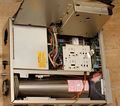2230: Difference between revisions
No edit summary |
No edit summary |
||
| Line 82: | Line 82: | ||
2230-1.jpg | 2230-1.jpg | ||
2230-2.jpg | 2230-2.jpg | ||
Tek 2230 right.jpg | |||
Tek 2230 interface.jpg | standard interface board (X-Y) | |||
Tek-2230f10-1.jpg | 2230 [[GPIB interface]] board | |||
Tek 2230 open.jpg | | |||
2230topboard.JPG | uppermost board (A10, CPU and acquisition) | 2230topboard.JPG | uppermost board (A10, CPU and acquisition) | ||
Tek | Tek 2230 service.jpg | CPU/scquisition board in service position | ||
</gallery> | </gallery> | ||
Revision as of 04:29, 9 October 2020
The Tektronix 2230 is a portable 100 MHz, dual-channel combination analog / digital storage scope, sister model of 2220 and 2221.
It has both an analog mode and a digital mode. In the digital storage mode, up to three waveform sets (CH 1 and/or CH 2) may be stored in a save ref. memory and recalled for display at a later time.
The 2230 features alphanumeric CRT readout of many of the front panel controls. A DB-9 auxiliary connector on the right side provides an external clock input as well as an analog X-Y plotter output to make permanent copies of the display. This feature can be accessed through the "Mem select" menu.
Some firmware versions have a diagnostics menu with the Tektronix logo and wizard image.
The Cursor knob is prone to failure. It becomes jittery and will not scroll properly.
Options include RS-232 and GPIB interface boards, which include a 32K (26K available) battery backed memory daughter board (the same options for the 2220 and 2221 do not include the memory).
Recommended cart is the K212.
Key Specifications
| — Vertical — | |
| Input impedance | 1 MΩ // 20 pF |
| Maximum Safe Input Voltage | 400 V (dc + peak AC) or 800 Vp-p AC |
| CMRR | At least 10:1 at 10 MHz |
| — Horizontal — | |
| Timebase A | 50 ns/Div to 0.5 s/Div, 1-2-5, x10 magnifier, i.e. down to 5 ns/Div. In "Store" mode lower sweep speeds up to 5 s/Div are available |
| Timebase B | 50 ns/Div to 5 s/Div, 1-2-5, x10 magnifier, i.e. down to 5 ns/Div |
| Bandwidth | 100 MHz (analog) |
| Sampling rate | 20 MS/s |
| Record length | 1K or 4K samples (single channel), optional 26K |
| Z axis | input (intensity); DC to 20 MHz, maximum safe input 30V (dc + peak ac) Input resistance about 10kΩ |
| CRT | display area : 8 × 10 cm² |
| Dimensions | With feet and handle: 137 x 361 x 511 mm³ |
| Features |
|
Links
Internals
The 2230 is controlled by an Intel 8088 microprocessor with firmware in a pair of 27512 EPROMs, and six TMS4426 16K×4 DRAMs. The A/D converter is a Sony CX20052A (8 bit, 20 MHz, ECL output). A pair of MCM2016H 2K×8, 70 ns RAMs serve as acquisition memory.
Custom Tek chips used include 155-0274-00 (A1U130, A1U180), 155-0273-00 (A2U30, A2U80), and 155-0022-00 (A10U2101). There is also a semi-custom part (A10U9208 Display Controller, 156-2452-00).
Pictures
-
-
-
-
-
-
-
standard interface board (X-Y)
-
2230 GPIB interface board
-
-
uppermost board (A10, CPU and acquisition)
-
CPU/scquisition board in service position









